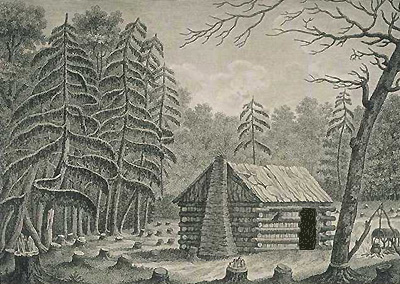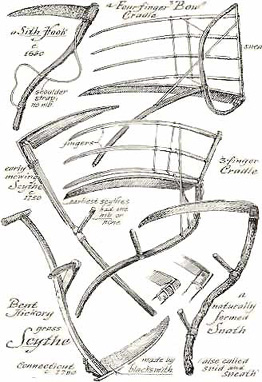 |
Colonial Man
![]()
North America in the 1700's was primarily a land of farmers. When colonists arrived they found a vast uncultivated area of valleys, plains, and rolling hills thickly covered in primeval forest. Most new colonists came to this area intending to clear the timber and plant crops for their living. There were of course a few ministers and artisans, traders and merchants, but they were few in number compared with the vast majority--the farmers.
 The
Hudson and the Mohawk valleys enjoyed particularly fertile land, which guaranteed
that individuals settling this country would be farmers. Most farmers worked
their lands with family labor, but some used indentured
servants to help meet their labor needs. By 1750, more than 1/2 the immigrants
south of New England were indentured. For a first person account of Indentured
Servitude read Gottlieb Mittelberger's letter
home.
The
Hudson and the Mohawk valleys enjoyed particularly fertile land, which guaranteed
that individuals settling this country would be farmers. Most farmers worked
their lands with family labor, but some used indentured
servants to help meet their labor needs. By 1750, more than 1/2 the immigrants
south of New England were indentured. For a first person account of Indentured
Servitude read Gottlieb Mittelberger's letter
home.
New York was by no means wholly agricultural. The second great industry was trade. There were two principle kinds: trade with foreign countries and the other colonies, and the Indian fur trade. The Indian fur trade was exceedingly lucrative, and hundreds of men were constantly engaged in it. New York City was the center of international trade and all maritime commerce, and was a formidable rival of Boston and Philadelphia.
At this time, New York had few factories, and colonists were forced to rely on their own ingenuity to provide necessities. Nearly every farmer was also a simple mechanic. He and his sons usually made the furniture for the household and many of the implements of the farm as well, while his wife and daughters spun flax and wove it into a coarse cloth from which the family's clothes were made.
Many farmers lived in or near the village. "Town" was a rural village with unpaved, shady streets partially filled with tree stumps. There were at least three important buildings in every town and surprisingly they were usually located near each other: the church, the tavern, and the blockhouse. The church was built of logs, and had benches for sitting and little else. The church's congregation was called to services by the sound of a horn or a drum, and the people sat in order of social rank and listened to long sermons. If a man or a boy fell asleep or misbehaved, he received a rap on the head from the rod of the tithingman. If a woman fell asleep, she was awakened by the brushing of her face with a rabbit's foot attached to the tithingman's rod.
The tavern was both a drinking house and a lodging place for travelers; it was also the center of gossip and news from the village and neighborhood. Here people would gather on special days to have a drink, to get the latest news, and to discuss politics and religion. The tavern was considered a public necessity, and a town that did not maintain one was subject to fine by the General Court. The principal drinks were rum and beer, and these were used freely by men, women, and children. The tavern keeper was considered an important community member. He was usually a good natured fellow whose information on all current topics was immense. He was required to be a man of good character, and was not allowed to sell strong drink to drunkards.

Home Page | Assessment
| Lesson 1 | Lesson
2 | Lesson 3 | Lesson
4 | Frontier
Characters
Learning Aids | Great
Law of Peace | US Constitution | Timeline
| Works Cited
© 1 October 2001, Portland State University